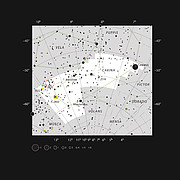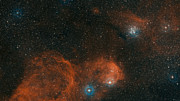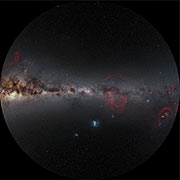Comunicato Stampa
Vita e morte di una famiglia di stelle
23 Luglio 2014
In questa nuova suggestiva immagine ottenuta all'Osservatorio dell'ESO di La Silla in Cile, giovani stelle in uno stretto abbraccio su uno sfondo di nubi di gas brillante e strisce di polvere. L'ammasso stellare, noto come NGC 3293, era probabilmente solo una nube di gas e polvere circa dieci milioni di anni fa, ma appena le stelle hanno iniziato a formarsi è divenuto il brillante gruppo di stelle che vediamo ora. Ammassi come questi sono laboratori celesti che permettono agli astronomi di capire meglio come evolvono le stelle.
Questo bellissimo ammasso stellare, NGC 3293, si trova a circa 8000 anni luce dalla Terra nella costellazione della Carena. È stato individuato per la prima volta dall'astronomo francese Nicolas-Louis de Lacaille nel 1751, durante il suo soggiorno in quello che ora è il Sudafrica, usando un piccolo telescopio di apertura di soli 12 millimetri. È uno degli ammassi più brillanti del cielo australe e si vede facilmente a occhio nudo in una notte buia e serena.
Gli ammassi stellari come NGC 3293 contengono stelle che si sono formate più o meno nello stesso periodo, alla stessa distanza dalla Terra e dalla stessa nube di gas e polvere e perciò con la stessa composizione chimica. Ne risulta che questi ammassi sono oggetti ideali per mettere alla prova le teorie sull'evoluzione stellare.
La maggior parte delle stelle qui visibili sono molto giovani e l'ammasso stesso ha meno di 10 milioni di anni. È proprio un bambino su scala cosmica, se si considera che il Sole, ancora di mezz'età, ha già 4,6 miliardi di anni. Queste stelle brillanti, giovani e blu sono abbondanti negli ammassi aperti come NGC 3293 e, per esempio, nel più conosciuto ammasso Kappa Crucis, noto anche come Scrigno di Gioie o NGC 4755.
Questi ammassi aperti si formano da un nube gigante di gas molecolare e le stelle sono tenute insieme dalla reciproca attrazione gravitazionale. Queste forze non sono in grado però di tenere unito l'ammasso a fronte di incontri ravvicinati con altri ammassi e nubi di gas a mano a mano che il gas e la polvere dell'ammasso stesso si dissipano. Perciò gli ammassi aperti vivono solo qualche centinaio di milioni di anni, diversamente dai loro cugini più grandi, gli ammassi globulari, che pososno sopravvivere per miliardi di anni e contengono un numero ben maggiore di stelle.
Anche se qualche indizio suggerisce che la formazione stellare non sia finita in NGC 3293, si pensa che la maggior parte, se non la totalità, della cinquantina di stelle di questo ammasso siano state formate in un unico evento. Ma anche se queste stelle hanno tutte la stessa età non hanno tutte lo stesso aspetto abbagliante di una stella durante la sua infanzia: alcune sembrano decisamente più vecchie, dando agli astronomi la possibilità di esplorare come e perchè le stelle evolvano con ritmi diversi.
Si prenda per esempio la stella brillante, di colore arancione, in basso a destra nell'ammasso. Questa enorme stella, una gigante rossa, quando si è formata era probabilmente la più grande e la più luminosa di tutta la cucciolata, ma le stelle brillanti bruciano in fretta. Quando la stella ha terminato il combustibile nel nucleo, la dinamica interna è cambiata e la stella ha iniziato a gonfiarsi e raffreddarsi, diventando la gigante rossa che ora osserviamo. Le giganti rosse sono al termine del loro ciclo vitale ma le sorelline di questa gigante rossa si trovano ancora in quella fase nota come PMS (pre-sequenza principale, dall'inglese "pre-main sequence") - il periodo che precede il lungo, stabile corso della normale vita di una stella. Vediamo queste stelle nel fiore della vita, calde luminose e bianche, su un sfondo polveroso e rosso.
Questa immagine è stata ottenuta con il WFI (Wide Field Imager) installato sul telescopio da 2,2 metri dell'MPG/ESO all'Osservatorio dell'ESO di La Silla nel Cile settentrionale.
Ulteriori Informazioni
L'ESO (European Southern Observatory, o Osservatorio Australe Europeo) è la principale organizzazione intergovernativa di Astronomia in Europa e l'osservatorio astronomico più produttivo al mondo. È sostenuto da 15 paesi: Austria, Belgio, Brasile, Danimarca, Finlandia, Francia, Germania, Gran Bretagna, Italia, Olanda, Portogallo, Repubblica Ceca, Spagna, Svezia, e Svizzera. L'ESO svolge un ambizioso programma che si concentra sulla progettazione, costruzione e gestione di potenti strumenti astronomici da terra che consentano agli astronomi di realizzare importanti scoperte scientifiche. L'ESO ha anche un ruolo di punta nel promuovere e organizzare la cooperazione nella ricerca astronomica. L'ESO gestisce tre siti osservativi unici al mondo in Cile: La Silla, Paranal e Chajnantor. Sul Paranal, l'ESO gestisce il Very Large Telescope, osservatorio astronomico d'avanguardia nella banda visibile e due telescopi per survey. VISTA, il più grande telescopio per survey al mondo, lavora nella banda infrarossa mentre il VST (VLT Survey Telescope) è il più grande telescopio progettato appositamente per produrre survey del cielo in luce visibile. L'ESO è il partner europeo di un telescopio astronomico di concetto rivoluzionario, ALMA, il più grande progetto astronomico esistente. L'ESO al momento sta progettando l'European Extremely Large Telescope o E-ELT (significa Telescopio Europeo Estremamente Grande), un telescopio da 39 metri che opera nell'ottico e infrarosso vicino e che diventerà "il più grande occhio del mondo rivolto al cielo".
La traduzione dall'inglese dei comunicati stampa dell'ESO è un servizio dalla Rete di Divulgazione Scientifica dell'ESO (ESON: ESO Science Outreach Network) composta da ricercatori e divulgatori scientifici da tutti gli Stati Membri dell'ESO e altri paesi. Il nodo italiano della rete ESON è gestito da Anna Wolter.
Links
- Immagini del telescopio da 2,2 metri dell'MPG/ESO
- Altre fotografie prese con il telescopio da 2,2 metri dell'MPG/ESO
- Fotografie di La Silla
Contatti
Richard Hook
ESO education and Public Outreach Department
Garching bei München, Germany
Tel.: +49 89 3200 6655
E-mail: rhook@eso.org
Anna Wolter (press contact Italia)
Rete di divulgazione scientifica dell'ESO
e INAF-Osservatorio Astronomico di Brera
Milano, Italy
Tel.: +39 02 72320321
E-mail: eson-italy@eso.org
Sul Comunicato Stampa
| Comunicato Stampa N": | eso1422it |
| Nome: | NGC 3293 |
| Tipo: | Milky Way : Star : Grouping : Cluster : Open Milky Way : Nebula |
| Facility: | MPG/ESO 2.2-metre telescope |
| Instruments: | WFI |
Our use of Cookies
We use cookies that are essential for accessing our websites and using our services. We also use cookies to analyse, measure and improve our websites’ performance, to enable content sharing via social media and to display media content hosted on third-party platforms.
ESO Cookies Policy
The European Organisation for Astronomical Research in the Southern Hemisphere (ESO) is the pre-eminent intergovernmental science and technology organisation in astronomy. It carries out an ambitious programme focused on the design, construction and operation of powerful ground-based observing facilities for astronomy.
This Cookies Policy is intended to provide clarity by outlining the cookies used on the ESO public websites, their functions, the options you have for controlling them, and the ways you can contact us for additional details.
What are cookies?
Cookies are small pieces of data stored on your device by websites you visit. They serve various purposes, such as remembering login credentials and preferences and enhance your browsing experience.
Categories of cookies we use
Essential cookies (always active): These cookies are strictly necessary for the proper functioning of our website. Without these cookies, the website cannot operate correctly, and certain services, such as logging in or accessing secure areas, may not be available; because they are essential for the website’s operation, they cannot be disabled.
Functional Cookies: These cookies enhance your browsing experience by enabling additional features and personalization, such as remembering your preferences and settings. While not strictly necessary for the website to function, they improve usability and convenience; these cookies are only placed if you provide your consent.
Analytics cookies: These cookies collect information about how visitors interact with our website, such as which pages are visited most often and how users navigate the site. This data helps us improve website performance, optimize content, and enhance the user experience; these cookies are only placed if you provide your consent. We use the following analytics cookies.
Matomo Cookies:
This website uses Matomo (formerly Piwik), an open source software which enables the statistical analysis of website visits. Matomo uses cookies (text files) which are saved on your computer and which allow us to analyze how you use our website. The website user information generated by the cookies will only be saved on the servers of our IT Department. We use this information to analyze www.eso.org visits and to prepare reports on website activities. These data will not be disclosed to third parties.
On behalf of ESO, Matomo will use this information for the purpose of evaluating your use of the website, compiling reports on website activity and providing other services relating to website activity and internet usage.
Matomo cookies settings:
Additional Third-party cookies on ESO websites: some of our pages display content from external providers, e.g. YouTube.
Such third-party services are outside of ESO control and may, at any time, change their terms of service, use of cookies, etc.
YouTube: Some videos on the ESO website are embedded from ESO’s official YouTube channel. We have enabled YouTube’s privacy-enhanced mode, meaning that no cookies are set unless the user actively clicks on the video to play it. Additionally, in this mode, YouTube does not store any personally identifiable cookie data for embedded video playbacks. For more details, please refer to YouTube’s embedding videos information page.
Cookies can also be classified based on the following elements.
Regarding the domain, there are:
- First-party cookies, set by the website you are currently visiting. They are stored by the same domain that you are browsing and are used to enhance your experience on that site;
- Third-party cookies, set by a domain other than the one you are currently visiting.
As for their duration, cookies can be:
- Browser-session cookies, which are deleted when the user closes the browser;
- Stored cookies, which stay on the user's device for a predetermined period of time.
How to manage cookies
Cookie settings: You can modify your cookie choices for the ESO webpages at any time by clicking on the link Cookie settings at the bottom of any page.
In your browser: If you wish to delete cookies or instruct your browser to delete or block cookies by default, please visit the help pages of your browser:
Please be aware that if you delete or decline cookies, certain functionalities of our website may be not be available and your browsing experience may be affected.
You can set most browsers to prevent any cookies being placed on your device, but you may then have to manually adjust some preferences every time you visit a site/page. And some services and functionalities may not work properly at all (e.g. profile logging-in, shop check out).
Updates to the ESO Cookies Policy
The ESO Cookies Policy may be subject to future updates, which will be made available on this page.
Additional information
For any queries related to cookies, please contact: pdprATesoDOTorg.
As ESO public webpages are managed by our Department of Communication, your questions will be dealt with the support of the said Department.





